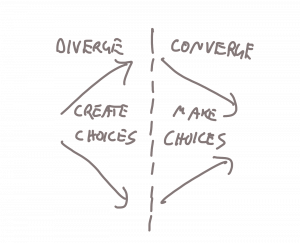So how do you hold a brainstorming session that does not suck?
- Invite the right people: Get a good group of people that are from a diversity of departments that have experience in different aspects of your product, company and customers and can bring those view points to the table. Make sure the group is not too big and not too small 6–10 is about right. Avoid inviting people just because.
- Find the right space: Find an open space with plenty of space to write on — white boards or walls to add sticky notes to do the trick. Make sure the setup is conducive to moving around preferable with a big round table in the middle so people can face each other or the presenter.
- Send an agenda: Make sure people know the objective for the session
- Assign roles: Most of the attendees will be the brainstormers, however, your meeting will be that much more structured if there is an un-objective person whose sole role is to keep it moving, and make sure that everyone’s voice is heard — this is usually the facilitator. Assign ahead of time the note taker whose role is to keep track of the top ideas by writing them on the board and then sharing out the learnings and next step as a wrap up of the conversation.
- Introduce Brainstorming rules:IDEO’s 7 rules are clear and to the point and will help level set the group on what is brainstorming. Although design and product might be used to the sticky note exercises others might not be.
- Get a facilitator: To ensure the session is truly unbiased and to learn yourself get a facilitator. This person, as an outsider, will not have baggage with the company and will allow you to be a part of the process.
- Kick it off right: Get the data qualitative or quantitative to ground the conversation and why you are taking the time out of your day to have it. Prepare the high level anchor question for the group that will set the stage for your session “How might we….”, and then articulate any sub-themes that you know are already focus areas.
- Start with a simple exercise: Get people out of their comfort zone and into a brainstorming mood with an easy opening exercise. For example ask the people in the room to spend 5 minutes drawing 5 others in the room. You’ll get a few “I don’t know how to draw” followed by laughter and people getting open to the idea that it’s not about the drawing ability but expressing the idea.
- Use tons of sticky notes and sharpies: Sticky notes are effective because they are fun and not like work so it allows every person to get out of their day to day and start thinking creatively. Why a marker and not a pen? Because this is about high level themes and ideas the more the better and what ifs rather than solving the how. If it does not fit on a sticky note using a sharpie it does not belong in this meeting as you have slipped into solution land. Don’t do this electronically if you can.
- Remote team members: Try to get them in the room if possible. If you have a team member that is remote make sure they are paired with a scribe in the room. Make an effort to let them be heard and get them to see the boards and ideas getting generated.
- Time constraint: Set a clear time for the sessions and keep the tempo moving (back to the need for a facilitator). Make sure there are stretch breaks and people stand up and walk around during the exercises as much as possible or you will start to loose people.
- Take care of the people: Make sure there are nutritional snacks in the room. Brainstorming consumes enormous amounts of mental energy and sucks us into itself because like a game it’s fun. Make sure to take care of the people in the room and their brains will remain productive.
- Focus the second half on getting to decisions: It is easy to get into a flurry of things you can do and ideas. That is the point of a brainstorming session. However, set aside the second half on clustering, grouping and getting to the focus set of things you will act on.
- Accountability and next steps: Assign who is taking the next steps and sharing out what you uncovered in this brainstorm and the next actionable steps. Make sure that follow up is sent the next day so the energy you uncovered in this session continues and the ideas that made it get the right start. Share your findings with the rest of the company to get the others focused on learning and aligned with you.
Alternative brainstorming approach
- Set the ground rules and goals
- Quantity over quality
- No critiques
- Build on ideas. Replace “yes, but…” with “yes, and…”
- Distribute sticky notes, sharpies
- Pose a question, user need or topic.
- Participants have 5 min to get as many ideas on sticky notes as possible. 1 idea per sticky note. Sharpies help because they are nice and thick — legible at a distance, and they prevent fine detail work.
- At the end of the 5m mark, go around and have people share their ideas.
- Put the ideas up on the board.
- Do this for 3 rounds. Toward the later rounds, new ideas tend to emerge, synthesized from others already shared.
- Cluster ideas by theme, topic, approach.
From https://medium.com/@elena.luneva/brainstorming-sessions-that-don-t-suck-23b12e7ccbd7 and http://gordonbrander.com/pattern/brainstorming/

